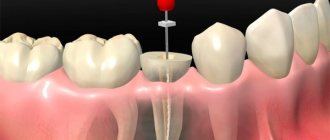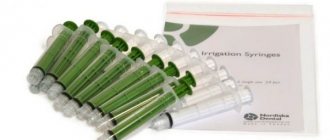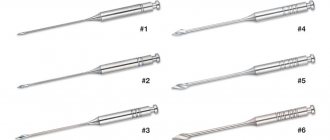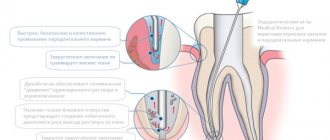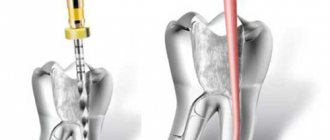The specific structure of the root canal determines the presence of a large number of branches, also known as microchannels. In situations where, as a result of filling, at least one of these cavities remains unclosed, there is a possibility of developing an inflammatory process, which, if prolonged, leads to tooth loss. The Thermafil system, which uses a soft gutta-percha composition, allows you to avoid such situations and achieve high-quality fillings.
What it is?
The Thermafil system is a new method of dental treatment used for effective filling of tooth canals.
To do this, heated gutta-percha is used on a plastic carrier - an obturator. Today, this is the most effective canal filling system with three-dimensional obturation and complete sealing of the apex. This treatment method significantly reduces the specialist’s work time and guarantees high-quality filling. Even the narrowest, curved canals can be reliably filled with filling material.
Use of thermophiles
Translated from Latin, the term “thermophilic bacteria” means “microorganisms that love heat.” They live in our environment: in parks, squares and forests, at the bottom of oceans and seas, they can be found not only in the human body, but also in animals.
Depending on the temperature regime, prokaryotes are divided into psychrophiles, mesophylls and thermophiles. Due to their beneficial properties, these bacteria are widely used in various sectors of the food and manufacturing industries, cosmetology and medicine.
Recently, thermophiles have been used especially widely in dentistry as the main material when filling root canals with gutta-percha.
Root canal filling with Thermofil system
Study of thermophiles
Thermophiles are microorganisms that appear, reproduce and exist in conditions of very high temperatures, at which many other organisms simply do not survive. These include some varieties of invertebrate worms, mold, mollusks, insects and plants.
The first experiments on studying these bacteria were carried out by the American scientist Thomas Brock, who in 1970 experimentally proved that strange microorganisms live in thermal springs of volcanic origin in Yellowstone Park. The peculiarity of thermophiles is that the best environment for their reproduction is high temperatures from 45 to 90 ° C.
Thermophilic organisms
The following pioneering research in this area was carried out after the discovery of hot springs in the ocean. Due to pressure differences, the water temperature in them can reach up to 300 °C. Scientists have discovered up to one hundred species of different bacteria, including thermophiles. On land, the highest temperature at which these bacteria can live is 122 °C.
Some biologists believe that distant relatives of thermophiles are prokaryotes (this type of bacteria also includes psychrophiles and mesophylls), which lived on Earth before the Ice Age. It is likely that thermophiles are the first inhabitants of our planet. Living and developing in volcanic deposits, they helped create the earth's biosphere.
Types of bacteria
There are several classifications of thermophiles according to different criteria. Depending on what temperature bacteria prefer, experts divide them into four groups:
- Thermo-tolerant species. They reproduce at temperatures from 10 to 60 °C. In this they differ significantly from mesophiles, which are able to exist only at very high temperatures. This group in its characteristics is close to psychrophiles - bacteria that die at temperatures above 20 ° C.
- Optional view. Microorganisms that can reproduce both at room temperature and at higher conditions (50 and 60 ° C).
- Obligate species. Only very high temperatures are suitable for them. If it is below 40 °C, then they die.
- Extreme look. Thermophiles that die at temperatures below 60 °C and thrive at 80–110 °C. Although these microorganisms can exist at the same high temperatures as mesophiles, they differ in their biological characteristics.
- Depending on how much oxygen the bacteria need to reproduce, they are divided into aerobic and anaerobic species.
Areas of application
Bacteria of this type are widely used in various fields:
- Food industry. Anaerobic thermophiles are used in the creation of dairy products (sourdoughs and yoghurts). Everyone knows about the benefits of these products. They contain many microelements that will be useful for both children and adults.
- Beauty industry. In cosmetology, various fermented milk products prepared with the help of thermophilic bacteria are successfully used. For example, yogurt restores skin elasticity and firmness and is the main component of whitening masks.
- Organic processing. During their life, thermophilic bacteria produce methane, which can be used as an alternative fuel for heating rooms and residential buildings.
- Soil cleaning. These microorganisms successfully fight clostridium - substances that form in the soil when large amounts of fertilizers are used. You can clean the soil from harmful substances and make it bear fruit by using thermophiles.
Application in dentistry
One of the most commonly used procedures in dentistry is tooth canal filling. It is very important that it is carried out without errors, otherwise complications may arise in the patient due to the development of pathogenic microbes.
Filling tooth canals with thermophile
The main material used for obturation (filling the canals with a medicinal substance) is gutta-percha, a product extracted from plant sap.
Filling with gutta-percha allows you to reliably and permanently solve the problem of diseased canals. From the 19th century to this day, a filling made from this material has been the best solution to the problem.
Filling canals using this method was invented by B. Johnson.
Medical technology is constantly improving, so a modern dental system has been developed that uses gutta-percha to fill the root canal.
Thermophile system
Filling canals with gutta-percha is a new progressive method that allows you to effectively treat teeth. Using this method, treatment is carried out quickly, giving excellent and reliable results.
Thermophile is a plastic or metal obturator (rod) of various diameters, coated with a layer of gutta-percha.
When heated, the substance becomes flexible and sticky, due to which it completely fills the canal and protects the tooth from possible infection.
Device for heating obturators
The process of filling with thermophile includes the following steps: heated gutta-percha is applied to the rod. After this, the doctor inserts the pin into the filling channels. In this case, the tooth root must be completely filled with the substance, otherwise inflammation may occur.
Vertical condensation of gutta-percha is often carried out - a technique in which the substance is applied continuously and always hot.
A correctly performed dental canal treatment procedure completely eliminates the possibility of the appearance and development of pathogenic microorganisms.
In addition, when using the Thermofil system, harmful and obsolete substances are not used as dental fillings.
Advantages and disadvantages of the method
The method of filling a tooth canal with gutta-percha has a number of the following advantages that distinguish it from other dental procedures:
- effective and high-quality filling;
- minimal risk of infection and development;
- high-quality non-toxic material;
- the doctor independently determines the depth of insertion of the rod;
- if repeated treatment is necessary, the pin is easily removed from the tooth root;
- the quality of treatment is not affected by the curvature of the root processes;
- Tooth canal treatment is painless.
The gutta-percha treatment method has virtually no disadvantages, except for one: after the material hardens, it shrinks.
This filling is expensive, so it is carried out in private dental clinics.
Source: https://zubnoimir.ru/zuby/termofily.html
General principles of the technique
This filling method was developed by Professor B. Johnson. Initially, metal rods coated with a primary gutta-percha layer were used as a carrier. Over time, the system has been improved and is now widely used in dentistry.
The thermophile consists of a hard plastic obturator that is coated with a layer of gutta-percha. For ease of use, the rods come in different thicknesses and tapers. Each of them has marks that allow you to control the depth of insertion.
When heated, gutta-percha acquires good adhesiveness, due to which it adheres perfectly to the rod, and then directly to the canal. Due to the fact that Thermafil contains a plastic carrier, shrinkage of the material is prevented.
The usage procedure is as follows:
- the plastic rod is treated with heated gutta-percha;
- the pin is inserted directly into the canal with slow movements;
- being under pressure, gutta-percha densely fills all existing branches and the rest of the channel itself.
This method of carrying out the procedure, due to the tight sealing of the entire root system, received its second name - volumetric filling.
After such treatment, the risk of possible development of pathogens inside the tooth is significantly reduced.
The use of the Thermofil system allows the use of fewer toxic composite materials. Thus, the severity of pain after tooth treatment is reduced.
The technique requires considerable financial costs to purchase the following tools:
- drill with a special endodontic attachment;
- ovens for heating gutta-percha;
- endodontic instruments, most of which are expensive and can only be used a few times.
All of the above explains why such a convenient and simple treatment procedure is not offered in all clinics, mainly in private institutions.
General overview
The technology under consideration is one of the new methods of dental treatment, and guarantees the reliability of filling by placing heated gutta-percha in the cavity of the open canal, the basis for which is a plastic obturator. Three-dimensional obturation and complete sealing of the apex eliminate the likelihood of negative side processes that occur during the rehabilitation period. In addition, filling technology reduces the duration of the procedure and is recommended for use even with severe curvature of the canals.
Developed by Professor Johnson, the technology initially involved the use of medical steel rods coated with a layer of plastic material as a carrier. In modern Thermofil models, rigid polymer obturators of various diameters and tapers are used, on which marks are applied to facilitate control of the immersion of the equipment.
Heated gutta-percha has improved adhesive properties, ensuring tight fixation both at the base and in the cavity of the tubules. The presence of a plastic rod prevents shrinkage of the material. The method of using the system includes:
- Treatment of the obturator with a filling mass;
- Gradual introduction of the pin into the canal cavity;
- Natural filling of branches and volume as a result of the created pressure.
The technology of volumetric filling reduces the likelihood of infection of dental tissue, and allows you to reduce the amount of composite materials, which represent a potential source of negative impact on the jaw region. Practice shows that the painful sensations characteristic of the recovery period after medical intervention are expressed to a lesser extent.
It is worth noting that the protocol under consideration is associated with the clinic’s expenses for the purchase of special equipment, including a drill equipped with an endodontic attachment, an oven for softening gutta-percha, as well as sets of disposable instruments. As a result, the cost of treatment with the Thermafil system is higher than with alternative methods.
Stages of filling
Filling a canal with Thermofil occurs in several stages:
- pulp is removed from the root space;
- the channel opening expands;
- the resulting cavity is given the shape of a cone;
- All infected dentin is removed from the walls of the cavity;
- using a special apex locator device, the depth of the hole is determined;
- the canal cavity is subjected to antiseptic treatment several times;
- the entire canal cavity is washed with Chlorhexidine;
- the canal lumen is thoroughly dried;
- introduction of sealer;
- introduction of plastic carrier;
- complete filling of the lumen;
- removal of excess material;
- condensation of gutta-percha in the canal mouth;
- Carrying out an x-ray of the filled tooth to confirm the high-quality filling of the hole;
- antiseptic treatment of the oral cavity after treatment.
The quality of filling is influenced by several main factors.
Correct determination of hole depth
This technique involves filling the entire tooth with gutta-percha, including the canal opening and all its branches. In case of incomplete filling, pathogenic microflora will begin to develop inside the tooth. The main reason for poor-quality filling is an error in measuring the depth of the hole. This treatment can lead to the following complications:
- development of the inflammatory process, formation of a cyst, periodontitis - in the absence of proper treatment, the tooth will have to be removed;
- the appearance of severe pain, which will turn into neuralgia.
To determine the depth of the hole, a photograph of the tooth should be taken. This will ensure that the measuring tool reaches the bottom.
Correct machining
It is carried out to sufficiently expand the channel opening and eliminate all surface defects and irregularities. Filling untreated canals is quite difficult due to their narrow size and curvature.
Filling root canals with Thermofil
The expression “nature abhors a vacuum” applies very appropriately to dentistry, namely to root canal treatment. There is probably not a person who is not familiar with such a dental procedure as removing a nerve from a tooth with subsequent filling of root canals. This is otherwise called endodontic treatment. Nerves have to be removed from teeth for many reasons, but most often due to complications of caries - pulpitis and periodontitis. After the nerve is removed from the tooth, an ignorant person may think that the treatment can be completed at this stage. The tooth doesn’t hurt, you can chew – what else do you need? But it's not that simple. An empty root canal, in fact, is an ideal “incubator” for the proliferation of pathogenic microbes. For the same reason, there are often relapses of inflammation in the peri-root tissues of teeth with incompletely or loosely sealed root canals. That is why in dentistry there are strict requirements for the quality of filling (obturation) of the root canals of teeth.
The generally accepted quality standard for root canal filling is dense and complete filling of the root canal. Density is ensured by the physical properties of the filling material, and completeness is ensured by the doctor’s qualifications. The fact is that the root canal must be sealed up to the apical hole, located at the tip of the root. Underfilling threatens with inflammatory complications (formation of cysts, granulomas), and overfilling (filling material extending beyond the root apex) can lead to pain after tooth treatment. The quality of filling the equine canals directly depends on the skill of the doctor.
Fig 1 Fig 2
Fig1. Cyst formation as a result of poor-quality root canal treatment
Figure 2. Fully sealed root canals
The main material for obturation (filling) of root canals is gutta-percha. Gutta-percha is a plant product obtained from the milky sap of tropical plants. In dentistry, specially processed gutta-percha is used, which gives it the required properties (density, radiopacity, flexibility, etc.). At the beginning of the 19th century, gutta-percha was recognized as the best material for filling root canals. From that moment on, scientists began to develop methods for using gutta-percha in dentistry.
Over time, dental materials and technologies have improved, which ultimately led to the emergence of such a root canal filling system as Temafil (Thermafil). Thermophil is a system for filling the root canals of teeth with heated (softened) gutta-percha.
Thermofil system for filling root canals consists of filling pins and a special heating device for softening the gutta-percha of the filling pin.
Fig 3 Fig 4
Fig 3. Thermafil obturators
Fig. 4. Device (oven) for heating obturators
A filling pin (obturator) is a cone-shaped rod (can be plastic or metal) coated with a thin layer of gutta-percha.
The method of filling root canals with the Thermafil system consists of several stages. First, the nerve (pulp – neurovascular bundle) is removed from the root canal using special instruments. The root canal is then widened and given a conical shape. During the expansion process, a layer of infected dentin (the inner tissue of the tooth) is removed from the walls of the root canal. To determine the length of the root canal, a special device is used - an apex locator. It allows you to very accurately determine the working length of the root canal, which is necessary for its full treatment and filling.
Fig 5 Fig 6
Fig 5. Apex locator
Fig 6. Instruments for mechanical treatment of root canals
An indispensable condition for complete root canal treatment is its high-quality antiseptic treatment. To do this, the canal is washed repeatedly during the treatment with a solution of a strong antiseptic (sodium hypochlorite, chlorhexidine).
When the root canal is mechanically and antiseptically treated, it is dried with paper points, which are inserted into the lumen of the canal.
Now you can proceed directly to filling the canal. Filling the root canals completes the treatment of pulpitis and the treatment of periodontitis. A special limiter on the Thermofil pin sets the length to which the obturator must be inserted to completely fill the root canal. Then the obturator is heated with a device to soften the gutta-percha. Before filling, a thin layer of sealant is applied to the walls of the root canal - a special paste that ensures the filling of all micro-branches of the canal. The heated obturator is smoothly inserted into the root canal up to the limiter. After which the obturator is cut to the mouth of the root canal and an X-ray image of the filled tooth is taken. After making sure that the root canal is fully filled, you can begin restoring the tooth, which is done at your next visit to the dentist.
Fig 7 Fig 8
Figure 7. Root canal filling with Thermafil obturator
Fig. 8. The obturator is cut to the level of the entrance to the root canal (canal mouth)
Advantages of the Thermophile method
The root canals of teeth have a complex anatomical structure. In most cases, the main root canal has many side branches - microchannels. As a rule, these branches are present in the apical third of the root canal - the area most critical to the quality of the filling. Unsealed branches of the main canal are potential sources of infection, leading to inflammatory complications and, as a result, tooth loss.
Fig 9 Fig 10
Fig. 9. An extensive network of branches of the root canal
Fig. 10. Complete obturation of the main canal and its branches with Thermafil
Conventional root canal filling methods do not always achieve the desired result, and voids present in the root canal after poor-quality filling often lead to complications.
The technique of filling canals with Thermofil does not have these disadvantages. Softened gutta-percha, introduced under pressure into the canal on a carrier (rod), completely fills the entire volume of the root canal, including its branches. When filling, the doctor clearly controls the depth of insertion of the rod, which allows the canal to be accurately filled to the apical foramen. The plasticity of the carrier (rod) makes it possible to fill even highly curved root canals. If it is necessary to re-treat or prepare the root canal for a pin structure (restoration of a tooth on a pin, restoration with a core inlay), Thermafil can be easily removed from the root canal.
X-ray pictures. Complete filling of root canals with Thermafil
The conducted studies have proven excellent sealing of the root canal after filling with Thermofil. It is 20 times higher than when filling the root canal with a conventional gutta-percha pin and four times higher than the same indicator when filling the root canal by introducing gutta-percha using a syringe.
Advantages and disadvantages
Among the main advantages of the system, the following advantages are worth noting:
- guarantee of highly effective hermetic sealing;
- the risk of developing an inflammatory process is unlikely;
- the material has a low level of toxicity;
- apical integrity;
- the ability to control the depth of insertion of the pins;
- if necessary, repeat the treatment, the rod is easily removed from the root hole;
- for high-quality filling of cavities, the curvature of the roots does not matter;
- After the treatment there is no pain.
The use of this technique minimizes the risk that microscopic voids will remain between the channel walls and the filler. This happens due to the fact that the middle of the channel is filled with a special rod, which plays the role of a seal.
Thermoplastic gutta-percha is a safe material. But among the large number of advantages, one main drawback of the material can be noted - slight shrinkage after curing.
When is the method most effective?
The use of the system is most effective in the following cases:
- for infectious lesions of the dental root system;
- when removal of the inflamed pulp is required;
- in case of severe curvature of channel branches and the channel itself;
- with the initial destruction of the root canal;
- to shape the cavity before filling;
- direct installation of the filling.
The most difficult case is the need to treat a previously filled tooth, if the filling of the holes was carried out poorly. In this case, three-dimensional filling is also at its best.
Many clinical studies have been conducted that have proven the effectiveness of the Thermofil system. With its help, it is possible to reliably seal the canal cavity while maintaining the result for many years to come.
